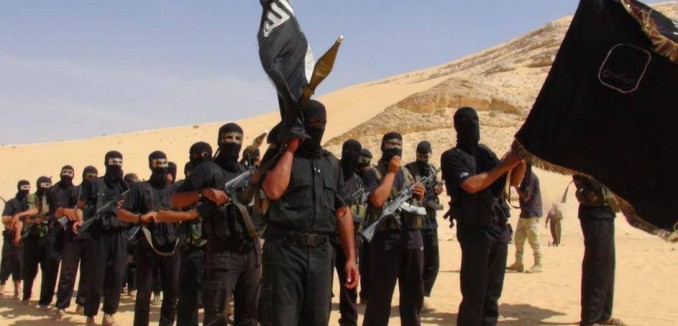Islamic State operatives are traveling to the Gaza Strip to receive medical treatment in hospitals controlled by the Iran-backed terrorist group Hamas, the Jerusalem Post reported on Monday, citing Israeli authorities.
“We have received authenticated reports that ISIS members in Sinai entered the Gaza Strip through tunnels in order to receive treatment at Hamas hospitals,” IDF Maj.-Gen. Yoav Mordechai, coordinator of government activities in the territories, told the online Arabic news site Elaph. He added that Islamic State fighters enter Gaza though the same tunnel network that Hamas uses to smuggle arms and explosives.
According to Mordechai, Hamas agreed to treat ISIS operatives in exchange for money, arms, and goods, all of which have been in short supply in the strip following Egypt’s aggressive campaign to destroy Hamas tunnels between Gaza and the Sinai Peninsula. The Egyptian military is currently fighting an insurgency in the Sinai against an Islamic State affiliate, known as Wilayat Sayna or ISIS-Sinai Province.
The Post added that sources familiar with the situation say Israel is keeping Egypt informed of ISIS’s movements in the peninsula and of the group’s relationship with Hamas, and has provided the Egyptian military with aerial photographs of tunnel openings along the Sinai-Gaza border. Egypt reportedly views Hamas’ agreement with ISIS gravely.
Ynet reported in December that Hamas has been funding ISIS-Sinai Province with tens of thousands of dollars per month in weapons sales, and that the IDF was intensifying efforts to collect information on the group after it issued several threats against Israel. ISIS-Sinai Province is believed to have thousands of jihadists in its ranks and receive millions of dollars in aid from funders abroad, giving it the capacity to attack Egyptian targets on a daily basis.
According to Egyptian authorities, Hamas’ logistical support and training was key in facilitating the rise of ISIS-Sinai Province. The ISIS affiliate’s leader, Shadi al-Menei, reportedly met with top Hamas leaders in December in an effort to bolster their coordination.
Al-Menei’s forces carried out a major attack in July against Egyptian troops in the northern Sinai, killing over a dozen. The group also claimed responsibility for striking an Egyptian naval vessel off of northern Sinai that same month, as well as for rockets fired into Israel’s southern region. An Israeli general confirmed at the time that Hamas was assisting ISIS-Sinai Province through arms smuggling and other means.
Times of Israel journalist Avi Issacharoff similarly characterized the relationship between the groups as one of “close cooperation” in July, adding that Hamas launched surveillance drones to track Egyptian troop movements near smuggling routes between Gaza and the Sinai. “These routes are vital to Hamas on one side of the border, and Islamic State on the other,” he explained.
The widening coordination between the terrorist organizations echoes Israeli Prime Minister Benjamin Netanyahu’s observation in his 2014 speech to the United Nations General Assembly that “ISIS and Hamas are branches of the same poisonous tree.”
Arik Agassi wrote in The Tower Magazine in January that ISIS-Sinai Province “has become one of the most powerful, dangerous, and effective in the region,” largely due to Iranian support by way of Hamas.
The Iran-Hamas-ISIS axis is part of Iran’s strategy of using proxy forces against U.S. allies like Egypt and Israel as part of a larger strategy to achieve hegemony over the Middle East. This has resulted in one of the region’s best kept secrets: An intensive cooperation mechanism between Iran, Hamas, and ISIS, based on money, weapons, military equipment, and training.
Iran’s foreign policy goal of hegemony over the Middle East is based on its primary ideological pillar – exporting the Islamic Revolution to other countries using terrorism and political subversion. In pursuing its ambitions, Iran has often put aside its religious differences with radical Sunni groups like ISIS and Hamas. The Islamic Republic is more than willing to cooperate with these groups as long as doing so helps promote its larger interests.
“By directly supporting Hamas in Gaza and indirectly supporting ISIS in the Sinai, Iran is able to gain foothold against Israel and Egypt to destabilize them, undermine America’s regional influence, create another Iranian power base in a Sunni-dominated region, and project its power and influence in its pursuit of regional hegemony,” Major (res.) Dan Feferman, a former senior IDF intelligence officer and Iran specialist, told the Tower. When asked why Iran would indirectly fund a serious rival such as ISIS, Feferman said that Lebanon, Iraq, and especially Syria are more important to Iran than the Sinai, as Iran wants to preserve its influence in states affected by the Syrian civil war – so Iran fights ISIS in those counties. In places where Iran does not have a strong influence, such as Egypt, it feels comfortable supporting ISIS, albeit indirectly.




